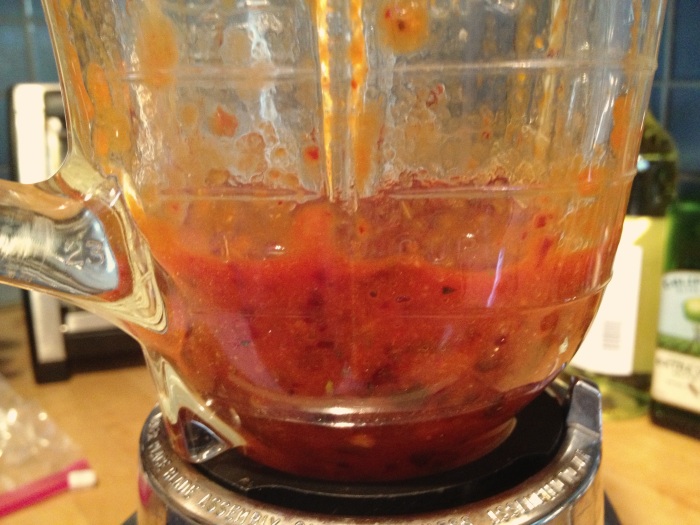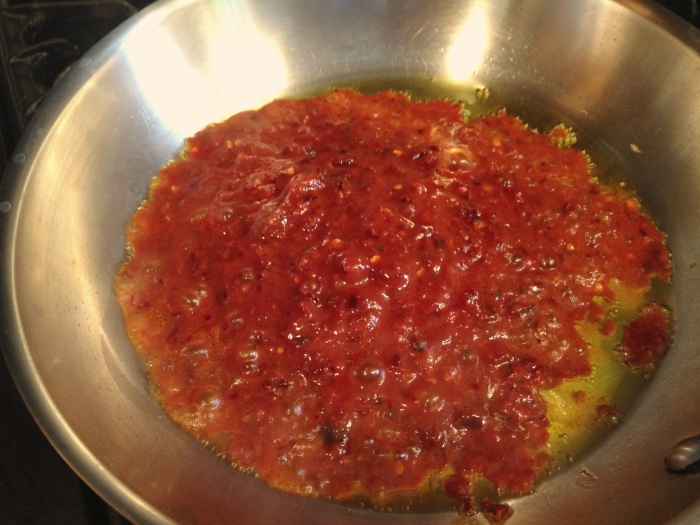Go into any Latino market and you will find a bewildering array of dried chiles. Guajillo, Puya, Pasilla, Chipotle, Ancho, Arbol. So many different shapes, colors and textures, different chiles for different dishes. Here at Hot Eddie’s we use all of ’em from the large sweet Ancho to the tiny, pea-sized Chiltepin. Each chile has a different flavor profile, type and level of heat: sweet, smoky, bright, earthy, fruity, mild, medium, spicy, early heat or late burn. It can be intimidating for someone just beginning to use dried chiles, where do you start?
Here are some of the most basic and popular chilies, readily available. Clockwise from the upper left: Ancho or Pasilla is a dried green poblano. Sweet, dark and fruity it is very mild. New Mexico has a mild bright taste used in Chile Colorado. The Chipotle is a smoked hot red Jalapeño, and adds a heavier spicy smoke flavor. It comes dried or canned in a vinegary adobo sauce. The Arbol is hot and very lively. The Puya is medium spicy and earthy. I use it to add another layer of flavor in salsas and Chile Colorado. The Guajillo is my workhorse. We use a lot of these. Medium spicy, and citrusy it has a classic dried chile flavor. Cayenne is often ground into a powder, and is hot and spicy. The Arbol, Cayenne and Chiltepin are hot up front but the heat diminishes quickly. Habenero (not pictured here) is mostly used fresh but you can also find it dried. It is very hot with a sweet fruity flavor at the outset but builds to a late, ongoing burn.
A bit of chile trivia. Many markets sell the large green fresh Poblano chile, used in Chile Relleno and Chile Verde as a Pasilla. This is not correct. The true Pasilla is the dried form of a smaller Chilaca pepper, also called a Chile Negro. The Ancho pictured above is actually a dried Poblano, sometimes called a Pasilla. Those names are often interchanged, but now you know the real deal. We’ll be using that fresh Poblano in an upcoming Chile Verde recipe soon.
You can usually find most of the ones pictured above at any good supermarket or large grocery store. Here in West Los Angeles, I hit up the Mar Vista Ranch Market on Venice Blvd., just west of Centinela. They have a great selection of dried chiles and other Productos Latinos. (Try the killer chile lime peanuts in the huge jar by the cashier.)
We’ll start with a basic dried chile salsa that is easy to make and, like most of the recipes here at Hot Eddie’s, it is just a starting point. Many of the dried chile salsas call for soaking the chiles in warm water for half an hour or so, but this one uses them as is. It is quick and easy and once you get the hang of the dried chile thing, you can mix and match, varying the proportions to create a range of salsas from sweet and smokey, to bright, hot and lively.
Salsa Roja Makes about a cup of salsa and takes about 30 minutes from start to finish.
Ingredients:
6 dried Guajillo chiles
2 cloves peeled garlic
1/4 small onion
1 medium tomato
¾-1 cup warm water
¼ teaspoon dried Mexican oregano or two fresh sprigs
1-2 teaspoons olive or vegetable oil
Salt.
Wipe the chiles with a damp cloth and put into a heavy frying pan over medium heat. Toast for about 20-30 seconds on a side until they darken slightly. Be careful not to burn them as it gives a bitter taste and you will have to discard them and start over.
I usually wear gloves when I work with chiles. It prevents unpleasant accidents when you forget and touch a sensitive spot on your face or body. I’ll say no more. Take the dried chiles and with a sharp knife slice them open along one side and remove the stems, seeds, and veins. Most of the heat is in those veins and seeds. I like my salsa hot, so I usually leave about half the seeds in. You can vary according to your taste.
Tear the cleaned chiles into chunks, roughly chop the tomato, onion and garlic. Put them into a blender and blend to roughly chop. It’s okay if there are some large pieces of the chiles.
Add 1/2 to 3/4 cups warm water and puree until smooth. Add more water if necessary to make it spoonable and a bit thin. Not so smooth that there aren’t some small pieces of chile, this salsa benefits from a little texture.
Film the heavy skillet with oil and put over medium heat till the oil shimmers. Add the salsa. It will sputter and dance, stand back and stir till it calms down. Simmer 8-10 minutes to cook the chiles, adding more water if it becomes too dry. You are going for a thin spoonable consistency.
This is good on tacos, sandwiches, over a tostada, even with chips. Store tightly covered in a container in the refrigerator. It will keep for a week or so. I usually have a jar of this on hand at all times.
Here is a variation using the same basic technique, that I call Salsa Fuego (it is fiery). You can cut back on the Habeneros if you want it toned down a bit I used the Ancho for sweetness, the Puya and Guajillo for flavor, the Chipotle for smoke and the Habaneros for late heat. Careful, it creeps up on you.
Salsa Fuego
4 dried Puya chiles
4 dried Guijillo chles
1 dried Ancho/Pasilla chile
1 dried Chipotle chile
4 dried Habanero chiles
1 clove garlic
1 tomato
¾ to 1 cup water
2 teaspoons vegetable oil
¼ tsp. salt
We had a salsa tasting at a family Taco Night dinner a while back and this next one was voted the favorite. It is sweet and citrusy with a little late heat from the Habaneros, but not too hot. If you like it hotter, just add more Habaneros, or a couple of Arbol chiles.
Taco Night Salsa Roja
8 dried Guajillo chiles
2 dried Habanero chiles
2 cloves fresh garlic
sprig fresh oregano
1 medium tomato
1/4 tsp. salt
1 tsp. vegetable oil
¾ – 1 cup water.
As you can see, there are endless variations of the basic recipe. The technique is exactly the same. You can also substitute a small tomatillo for the tomato to give the salsa a little extra tang. Please experiment with the bounty of chiles that are out there and let me know if you hit on any good combinations. Enjoy.











Pingback: New Mexico Red Chile Sauce | Hot Eddie's